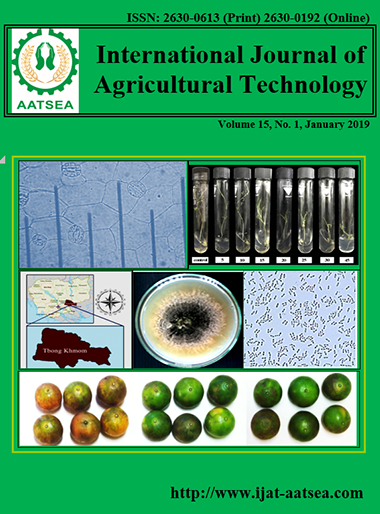Antimicrobial properties of extracts from Carissa carandas L. fruits and its application in chilled and frozen ground pork
Main Article Content
Abstract
In vitro antimicrobial activities of Carissa carandas L. fruit extracts dissolved in water and their effect on biological qualities in ground pork during storage period for 8 days at 4 oC and at -20 oC for 12 weeks were investigated. The antimicrobial avctivity was carried out using agar well diffusion method against food pathogenic and spoilage bacteria. For antimicrobial testing, water extracts of C. carandas inhibited both pathogenic and spoilage bacteria including Salmonella Typhimurium TISTR 292, Staphylococcus aureus TISTR 118, Escherichia coli TISTR 780, Aeromonas hydrophila TISTR 1321, Pseudomonas fluorescens TISTR 358 and Bacillus coagulans TISTR 1447, at the concentration of 50 mg/ml. The water extract of C. carandas fruit was applied in ground pork. The ground pork samples were subjected to four treatments including control (non-treated), 0.2 g BHT/kg meat, 2.5 g and 5 g extracts /kg meat. Total microbial count, yeast/mold, psychrophilic bacteria and coliforms were determined in ground pork during storage time for 0, 2, 4, 6 and 8 days at 4 oC and frozen ground pork storage at -20 oC for 0, 4, 8, and 12 weeks. The results showed that pH was not different in each treatments. Total plate count and coliforms bacteria was decreased after adding 5 g extracts /kg meat at 6-8 days in chilled ground pork and up to 8 and 12 weeks in frozen ground pork. This finding indicated that C. carandas fruit extracts could be used for natural antimicrobial in ground pork for prolong shelf-life.
Article Details

This work is licensed under a Creative Commons Attribution-NonCommercial-NoDerivatives 4.0 International License.
References
A. O. A. C. (1995). (AOAC). Official Methods of Analysis. Association of Official Analytical Chemists. AOAC international. 14th Ed. Wasington DC: AOAC international.
Biswas, B., Rogers, K., Mclaughlin, F., Daniels, D. and Yadav, A. (2013). Antimicrobial activities of leaf extracts of guava (Psidium guajava L.) on two gram-negative and gram-positive bacteria. International Journal of Microbiology. http://dx.doi.org/10.1155/2013/746165.
Böhme, K., Fernández-No, I. C., Barros-Velázquez, J., Gallardo, J. M., Cañas, B. and Calo-Mata, P. (2012). Species Identification of food spoilage and pathogenic bacteria by MALDI-TOF Mass Fingerprinting. Food Quality and Preference. 32:29-46.
Boskovica, M., Zdravkovic, N., Ivanovic, J., Janjic, J., Djordjevic, J., Starcevic, M. and Baltic, M. Z. (2015). Antimicrobial activity of Thyme (Tymus vulgaris) and Oregano (Origanum vulgare) essential oils against some food-borne microorganisms. Procedia Food Science. 5:18-21.
Fullerton, M., Khatiwada, J., Johnson, J. U., Davis, S. and Williams, L. L. (2011). Determination of antimicrobial activity of sorrel (Hibiscus sabdariffa) on Esherichia coli O157:H7 isolated from food, veterinary, and clinical samples. Journal of Medicinal Food. 14:950-956.
Israr, F., Hassan, F., Naqvi, B. S., Azhar, I., Jabeen, S. and Hasan, S. M. F. (2012). Report: Studies on antibacterial activity of some traditional medicinal plants used in folk medicine. Pakistan Journal of Pharmaceutical Sciences. 25:669-674.
Jałosińska, M. and Wilczak, J. (2009). Influence of plant extracts on the microbiological shelf life of meat products. Polish Journal of Food and Nutrition Sciences. 59:303-308.
Kumar, S., Gupta, P. and Gupta, K. L.V. (2013). A critical review on Karamarda (Carissa carandas Linn.). International Journal of Pharmaceutical and Biological Archive. 4:637-642.
Mor-Mur, M. and Yuste, J. (2010). Emerging bacterial pathogens in meat and poultry: An overview. Food and Bioprocess Technology. 3:24-35.
Munuswamy, H., Thirunavukkarasu, T., Rajamani, S., Elumalai, E. K. and Ernest, D. (2013). A review on antimicrobial efficacy of some traditional medicinal plants in Tamilnadu. Journal of Acute Disease. 2:99-105.
Negi, P. S. (2012). Plant extracts for the control of bacterial growth: Efficacy, stability and safety issues for food application. International Journal of Food Microbiology. 156:7-17.
Obeidat, M., Shatnawi, M., Al-alawi, M., Al-Zubi, E., Al-Dmoor, H., Al-Qudah, M., EI-Qudah, J. and Otri, I. (2012). Antimicrobial activity of crude extracts of some plant leaves. Research Journal of Microbiology. 7:59-67.
Salar, R. K. and Dhall, A. (2010). Antimicrobial and free radical scavenging activity of extracts of some Indian medicinal plants. Journal of Medicinal Plants Research. 4:2313-2320.
Śmiecińska, K., Hnatyk, N., Daszkiewicz, T., Kubiak, D. and Matusevičius, P. (2015). The effect of frozen storage on the quality of vacuum-packaged turkey meat. Veterinarija ir Zootechnika. 71:61-66.
Sokmen, A., Gulluce, M., Askin Akpulat, H., Daferera, D., Tepe, B., Polissiou, M., Sokmen, M. and Sahin, F. (2004). The in vitro antimicrobial and antioxidant activities of the essential oils and methanol extracts of endemic Thymus spathulifolius. Food Control. 15:627-634.
Taie, H. A. A., Salama, Z. A. E. R. and Radwan, S. (2010). Potential activity of basil plants as a source of antioxidants and anticancer agents as affected by organic and bio-organic fertilization. Notulae Botanicae Horti Agrobotanici Cluj-Napoca. 38:119-127.
Vaghasiya, Y. and Chanda, S. V. (2007). Screening of methanol and acetone extracts of fourteen Indian medicinal plants for antimicrobial activity. Turkish Journal of Biology. 32:243-248.
Vashist, H. and Jindal, A. (2012). Antimicrobial activities of medicinal plants –Review. International Journal of Research in Pharmaceutical and Biomedical Sciences. 3:222-230.


